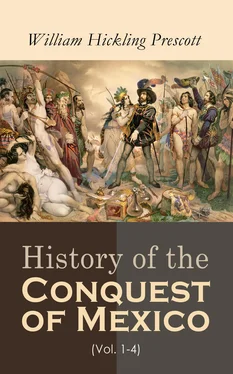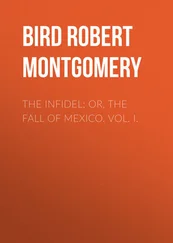In seeking for analogies with the Old World, we should not pass by in silence the architectural remains of the country, which, indeed, from their resemblance to the pyramidal structures of the East, have suggested to more than one antiquary the idea of a common origin. [425]The Spanish invaders, it is true, assailed the Indian buildings, especially those of a religious character, with all the fury of fanaticism. The same spirit survived in the generations which succeeded. The war has never ceased against the monuments of the country; and the few that fanaticism has spared have been nearly all demolished to serve the purposes of utility. Of all the stately edifices, so much extolled by the Spaniards who first visited the country, there are scarcely more vestiges at the present day than are to be found in some of those regions of Europe and Asia which once swarmed with populous cities, the great marts of luxury and commerce. [426]Yet some of these remains, like the temple of Xochicalco, [427]the palaces of Tezcotzinco, [428]the colossal calendar-stone in the capital, are of sufficient magnitude, and wrought with sufficient skill, to attest mechanical powers in the Aztecs not unworthy to be compared with those of the ancient Egyptians.
But, if the remains on the Mexican soil are so scanty, they multiply as we descend the southeastern slope of the Cordilleras, traverse the rich Valley of Oaxaca, and penetrate the forests of Chiapa and Yucatan. In the midst of these lonely regions we meet with the ruins, recently discovered, of several ancient cities, Mitla, Palenque, and Itzalana or Uxmal, [429]which argue a higher civilization than anything yet found on the American continent; and, although it was not the Mexicans who built these cities, yet, as they are probably the work of cognate races, the present inquiry would be incomplete without some attempt to ascertain what light they can throw on the origin of the Indian, and consequently of the Aztec civilization. [430]
Few works of art have been found in the neighborhood of any of the ruins. [431]Some of them, consisting of earthen or marble vases, fragments of statues, and the like, are fantastic, and even hideous; others show much grace and beauty of design, and are apparently well executed. [432]It may seem extraordinary that no iron in the buildings themselves, nor iron tools, should have been discovered, considering that the materials used are chiefly granite, very hard, and carefully hewn and polished. Red copper chisels and axes have been picked up in the midst of large blocks of granite imperfectly cut, with fragments of pillars and architraves, in the quarries near Mitla. [433]Tools of a similar kind have been discovered, also, in the quarries near Thebes; and the difficulty, nay, impossibility, of cutting such masses from the living rock with any tools which we possess, except iron, has confirmed an ingenious writer in the supposition that this metal must have been employed by the Egyptians, but that its tendency to decomposition, especially in a nitrous soil, has prevented any specimens of it from being preserved. [434]Yet iron has been found, after the lapse of some thousands of years, in the remains of antiquity; and it is certain that the Mexicans, down to the time of the Conquest, used only copper instruments, with an alloy of tin, and a silicious powder, to cut the hardest stones, some of them of enormous dimensions. [435]This fact, with the additional circumstance that only similar tools have been found in Central America, strengthens the conclusion that iron was neither known there nor in ancient Egypt.
But what are the nations of the Old Continent whose style of architecture bears most resemblance to that of the remarkable monuments of Chiapa and Yucatan? The points of resemblance will probably be found neither numerous nor decisive. There is, indeed, some analogy both to the Egyptian and Asiatic style of architecture in the pyramidal, terrace-formed bases on which the buildings repose, resembling also the Toltec and Mexican teocalli . A similar care, also, is observed in the people of both hemispheres to adjust the position of their buildings by the cardinal points. The walls in both are covered with figures and hieroglyphics, which, on the American as on the Egyptian, may be designed, perhaps, to record the laws and historical annals of the nation. These figures, as well as the buildings themselves, are found to have been stained with various dyes, principally vermilion; [436]a favorite color with the Egyptians also, who painted their colossal statues and temples of granite. [437]Notwithstanding these points of similarity, the Palenque architecture has little to remind us of the Egyptian or of the Oriental. It is, indeed, more conformable, in the perpendicular elevation of the walls, the moderate size of the stones, and the general arrangement of the parts, to the European. It must be admitted, however, to have a character of originality peculiar to itself.
More positive proofs of communication with the East might be looked for in their sculpture and in the conventional forms of their hieroglyphics. But the sculptures on the Palenque buildings are in relief, unlike the Egyptian, which are usually in intaglio . The Egyptians were not very successful in their representations of the human figure, which are on the same invariable model, always in profile, from the greater facility of execution this presents over the front view; the full eye is placed on the side of the head, while the countenance is similar in all, and perfectly destitute of expression. [438]The Palenque artists were equally awkward in representing the various attitudes of the body, which they delineated also in profile. But the parts are executed with much correctness, and sometimes gracefully; the costume is rich and various; and the ornamented head-dress, typical, perhaps, like the Aztec, of the name and condition of the person represented, conforms in its magnificence to the Oriental taste. The countenance is various, and often expressive. The contour of the head is, indeed, most extraordinary, describing almost a semi-circle from the forehead to the tip of the nose, and contracted towards the crown, whether from the artificial pressure practised by many of the aborigines, or from some preposterous notion of ideal beauty. [439]But, while superior in the execution of the details, the Palenque artist was far inferior to the Egyptian in the number and variety of the objects displayed by him, which on the Theban temples comprehend animals as well as men, and almost every conceivable object of use or elegant art.
The hieroglyphics are too few on the American buildings to authorize any decisive inference. On comparing them, however, with those of the Dresden Codex, probably from this same quarter of the country, [440]with those on the monument of Xochicalco, and with the ruder picture-writing of the Aztecs, it is not easy to discern anything which indicates a common system. Still less obvious is the resemblance to the Egyptian characters, whose refined and delicate abbreviations approach almost to the simplicity of an alphabet. Yet the Palenque writing shows an advanced stage of the art, and, though somewhat clumsy, intimates, by the conventional and arbitrary forms of the hieroglyphics, that it was symbolical, and perhaps phonetic, in its character. [441]That its mysterious import will ever be deciphered is scarcely to be expected. The language of the race who employed it, the race itself, is unknown. And it is not likely that another Rosetta stone will be found, with its trilingual inscription, to supply the means of comparison, and to guide the American Champollion in the path of discovery.
It is impossible to contemplate these mysterious monuments of a lost civilization without a strong feeling of curiosity as to who were their architects and what is their probable age. The data on which to rest our conjectures of their age are not very substantial; although some find in them a warrant for an antiquity of thousands of years, coeval with the architecture of Egypt and Hindostan. [442]But the interpretation of hieroglyphics, and the apparent duration of trees, are vague and unsatisfactory. [443]And how far can we derive an argument from the discoloration and dilapidated condition of the ruins, when we find so many structures of the Middle Ages dark and mouldering with decay, while the marbles of the Acropolis and the gray stone of Pæstum still shine in their primitive splendor?
Читать дальше












